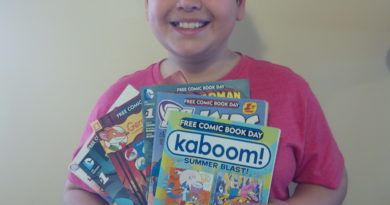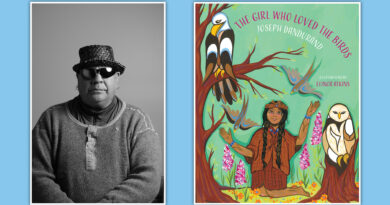Indigenous footprints on nature’s path: Louise Zimanyi discusses co-authoring the arresting new picture book “Walking Together”

Walking Together, co-written by early childhood care and education expert Louise Zimanyi and Elder Albert Marshall and illustrated by Emily Kewageshig, invites young readers and adults to explore the themes of nature, sustainability, biodiversity, and reciprocity.
Published by Annick Press, the book features vibrant illustrations and complex ideas narrated in spare, simple language that will engage even the youngest reader and deepen their understanding of Indigenous perspectives, the significance of learning in nature, and our responsibility to the planet.
Zimanyi has always had a deep connection to nature. Some of her earliest memories are of playful experiences at the beach, dressed in her red bathing suit and surrounded by sand, shells, and sticks. Naturally, she believes that “connecting to nature in the earliest years is important for playful learning throughout life.” And this philosophy has shaped her lifelong commitment to working in the field of early childhood care, development, and education. Her diverse experience includes teaching at post-secondary institutions and engaging in advocacy, policy work, and research with a focus on connecting children to nature from an early age.
The specific inspiration for Walking Together is Zimanyi’s co-learning journey with Elder Albert Marshall. Elder Albert Marshall’s belief that “the exchange of stories is the foundation of any and all relationships” played a significant role in shaping the book’s narrative. She also draws from her experiences working with children and early childhood education students at Humber College; her doctoral research on (re)storying children’s nature encounters through Two-Eyed Seeing; and her work with a knowledge/research collective of Indigenous and non-Indigenous faculty, Elders, and Knowledge holders at Humber College – including Marshall. Zimanyi is deeply grateful for the collaborative process, and highlights how the contributions of the team at Annick and illustrator, Emily Kewageshig enriched the journey of creating the book.

As an educator herself, she foresees Walking Together being a valuable classroom resource. In fact, she provides specific suggestions on how teachers can utilize the book to teach about Indigenous perspectives and our relationship and responsibility to the world. For instance, she encourages reading, discussing, and interacting with the book outdoors, and allowing children to engage with finger and hand puppets to enhance their understanding. “When experiencing and connecting to – and with – nature from multiple perspectives, we learn about the animals and plants. But we also learn their stories, purpose, and connection to each other and the ecosystems in which they live,” she explains.
Zimanyi stresses the importance of two concepts: Etuaptmumk, a Mi’kmaw term meaning the gift of multiple perspectives, also known as Two-Eyed Seeing; and Netukulimk, which means protecting Mother Earth for the ancestors and for present and future generations. By embracing the concept of Two-Eyed Seeing, which braids Indigenous and non-Indigenous perspectives together for the benefit of all – including our eco-kin – readers can gain a deeper understanding of the interconnectedness of all living beings and the importance of harmonious coexistence. “Nature has rights, and we have responsibilities,” Zimanyi notes. “This means we leave Mother Earth a better place than we found it.”

“Two-Eyed Seeing is about enacting Walking Together in a good way” – wherever it is that you live, play and work. “Everyday, wherever you are—in a park, in your backyard, in the forest, at a river, lake, or ocean—know that you are never alone,” she explains. You should “watch, listen, and wonder. What is nature teaching you about the plants and the animals and about yourself? How can you say thank you and show your gratitude?” As part of Truth and Reconciliation, she encourages us to embrace Land as a teacher and continue to (re)learn our connection to and with the Land through spirit, heart, mind, and body. During this United Nations Decade of Indigenous Languages (2022–2032), she quotes Elder Albert that “this has to be part of language revitalization, as Indigenous languages and wisdoms are from the Land.”
Walking Together offers a compelling and layered interplay between the text and illustrations. Zimanyi underscores how the words and images tell different but complementary stories, and urges readers to pay close attention to their emotional responses, and to imagine and think beyond what they see on the pages. Although authors often have limited involvement in the selection of an illustrator, Zimanyi and Elder Marshall had the opportunity to contribute specific ideas about the book’s visual style, and to offer suggestions for images that would enhance the text’s message. And the result is more than they could have hoped: “We were really moved by the ways Emily understood and interpreted the words and ideas.”
When asked about her favorite spread in the book, Zimanyi struggles to choose just one. She highlights a page where deer are drinking water because she is captivated by its vivid blue tones. She cites another page where children are depicted holding hands, likening their connection to the roots of a tree – a powerful metaphor for working together. This specific teaching originates from the late Mi’kmaw Spiritual Leader and Healer Chief Charles Labrador, as shared by Elder Albert Marshall: ““Go into the forest; you see the Birch, Maple, Pine. Look underground and all those trees are holding hands. We as people must do the same.” Reflecting on the illustrations and the ideas, her bottom line is unsurprising: “One has to read and experience each page to appreciate the message.”

A gratifying surprise has been the broad appeal of Walking Together. The picture book has touched the hearts and minds of diverse audiences – from the youngest of children, to adults working in outdoor learning and environmental education, to Indigenous Elders and Knowledge Holders. “What is beautiful about co-authoring the book with Elder Albert Marshall is that each page is a blend of sharing and exchanging stories based on multiple perspectives and experiences.” Zimanyi is delighted by the discussion and reflection – and the sense of cel;ebration and connection – that have been prompted by the book. These responses exemplify the power of storytelling and embody the importance of nurturing our relationship with nature.
An arresting picture book about our coexistence with nature, Walking Together is a valuable resource for homes and classrooms that promises both to stop us in our tracks and inspire us to get up and walk, talk and wonder together.
© Arpita Ghosal, Sesayarts Magazine, 2023
About The Author
Arpita Ghosal
Arpita Ghosal is a Toronto-based arts writer. She founded Sesaya in 2004 and SesayArts Magazine in 2012.
Visit About Us > Meet the Team to read Arpita’s full bio …




